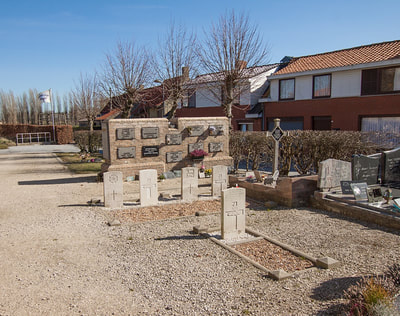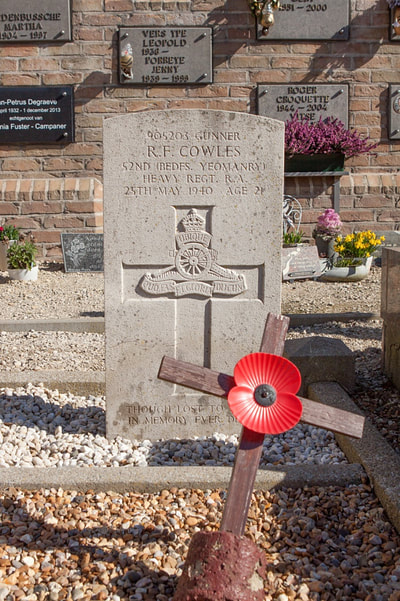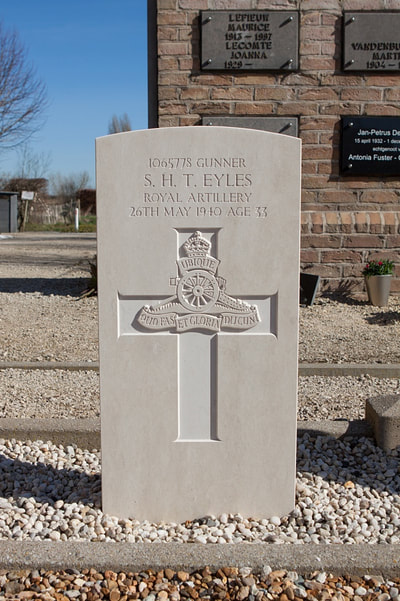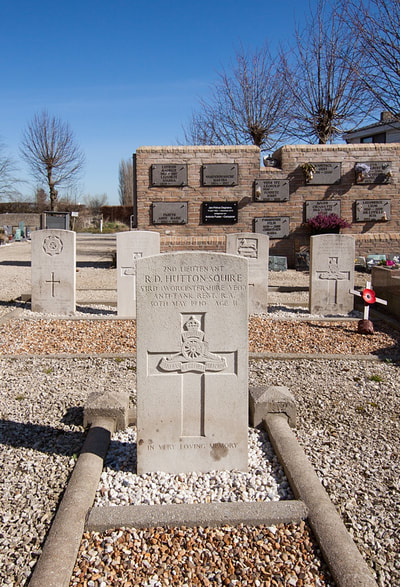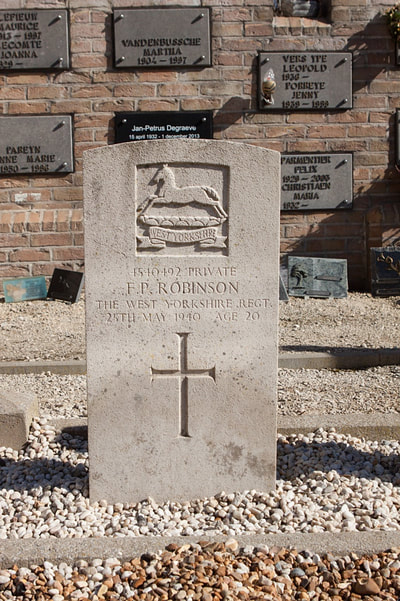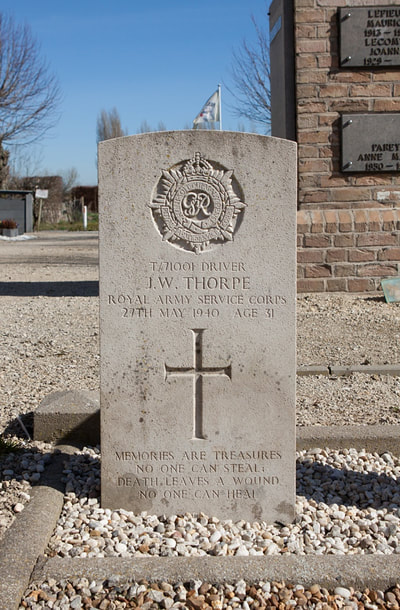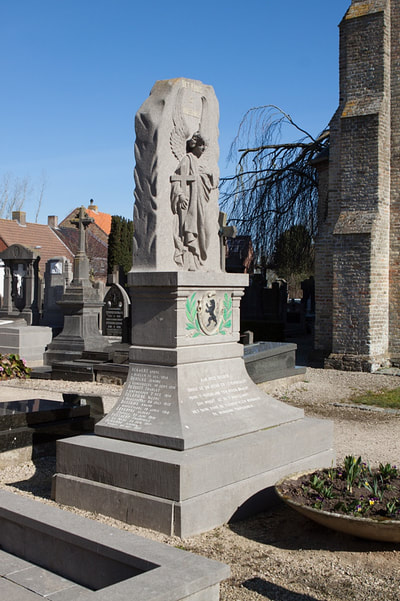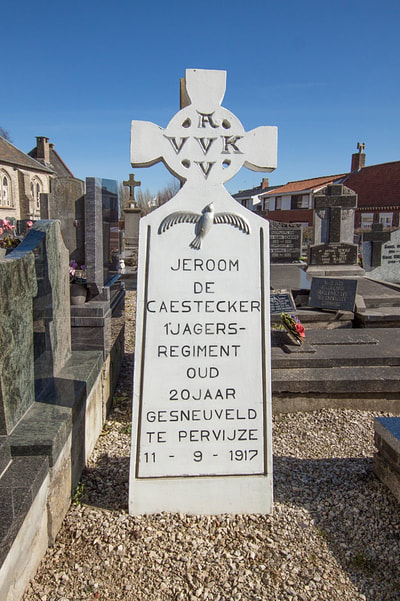PROVEN CHURCHYARD
West-Vlaanderen
Belgium
GPS Coordinates: Latitude: 50.89101, Longitude: 2.6574
Location Information
Proven Churchyard is located 17 Km north west of Ieper town centre on the N308 connecting Ieper to Poperinge and on to Oostcappel.
From Ieper town centre the Poperingseweg (N308), is reached via Elverdingsestraat then directly over two small roundabouts in the J. Capronstraat. The Poperingseweg is a continuation of the J. Capronstraat and begins after a prominent railway level crossing.
On reaching the ring road of Poperinge R33 Europalaan,the left hand clockwise route circles the town of Poperinge and rejoins the N308 towards Oost Cappel. 6.5 Km after joining the N308 lies the village of Proven.
The churchyard is located centrally in the village on the Alexisplein, which is just behind the main through road, the Provenplein.
Historical Information
The British Expeditionary Force was involved in the later stages of the defence of Belgium following the German invasion in May 1940, and suffered many casualties in covering the withdrawal to Dunkirk.
Proven Churchyard contains five Commonwealth burials of the Second World War.
Churchyard pictures © Werner Van Caneghem
Proven Churchyard is located 17 Km north west of Ieper town centre on the N308 connecting Ieper to Poperinge and on to Oostcappel.
From Ieper town centre the Poperingseweg (N308), is reached via Elverdingsestraat then directly over two small roundabouts in the J. Capronstraat. The Poperingseweg is a continuation of the J. Capronstraat and begins after a prominent railway level crossing.
On reaching the ring road of Poperinge R33 Europalaan,the left hand clockwise route circles the town of Poperinge and rejoins the N308 towards Oost Cappel. 6.5 Km after joining the N308 lies the village of Proven.
The churchyard is located centrally in the village on the Alexisplein, which is just behind the main through road, the Provenplein.
Historical Information
The British Expeditionary Force was involved in the later stages of the defence of Belgium following the German invasion in May 1940, and suffered many casualties in covering the withdrawal to Dunkirk.
Proven Churchyard contains five Commonwealth burials of the Second World War.
Churchyard pictures © Werner Van Caneghem

94528 Second Lieutenant
Robert David Hutton-Squire
53 (The Worcestershire Yeomanry) Anti-Tank Regiment
0th May 1940, aged 31.
Son of John Redmond Hutton-Squire and Gladys Maud Hutton-Squire, of Leeming Bar, Yorkshire.
His headstone bears the inscription "In Very Loving Memory"
Robert David Hutton-Squire
53 (The Worcestershire Yeomanry) Anti-Tank Regiment
0th May 1940, aged 31.
Son of John Redmond Hutton-Squire and Gladys Maud Hutton-Squire, of Leeming Bar, Yorkshire.
His headstone bears the inscription "In Very Loving Memory"
Other Burial Details
905203 Gunner Robert Frederick Cowles, 52 (The Bedfordshire Yeomanry) Heavy Field Regiment, died 25th May 1940, aged 21. Son of George and Rose Jane Cowles, of Biggleswade, Bedfordshire.
1065778 Gunner Samuel Herbert Thomas Eyles, 4 Medium Regiment, Royal Artillery, died 26th May 1940, aged 33.
4540492 Private Fred Pitt Robinson, 2/5th Bn. West Yorkshire Regiment (Prince of Wales's Own), died 25th May 1940, aged 20. Son of Hubert and Annie Robinson, of Bradford, Yorkshire.
T/71001 Driver John William Thorpe, 4 Division Petrol Company, Royal Army Service Corps, died 27th May 1940, aged 31.
Son of John and Alice Thorpe, of Keighley, Yorkshire; husband of Helene Thorpe, of Keighley.
905203 Gunner Robert Frederick Cowles, 52 (The Bedfordshire Yeomanry) Heavy Field Regiment, died 25th May 1940, aged 21. Son of George and Rose Jane Cowles, of Biggleswade, Bedfordshire.
1065778 Gunner Samuel Herbert Thomas Eyles, 4 Medium Regiment, Royal Artillery, died 26th May 1940, aged 33.
4540492 Private Fred Pitt Robinson, 2/5th Bn. West Yorkshire Regiment (Prince of Wales's Own), died 25th May 1940, aged 20. Son of Hubert and Annie Robinson, of Bradford, Yorkshire.
T/71001 Driver John William Thorpe, 4 Division Petrol Company, Royal Army Service Corps, died 27th May 1940, aged 31.
Son of John and Alice Thorpe, of Keighley, Yorkshire; husband of Helene Thorpe, of Keighley.
Joseph Alphonse Marie (Joe) English (Bruges, 5 August 1882 – Vinkem, 31 August 1918) was a Flemish draughtsman and painter.
His father was an Irishman who married a Flemish woman. Later on, Joe was naturalised as a Belgian subject and collaborated closely with the Antwerp artist Juliaan Devriendt. Antwerp was at that time the centre of the Flemish Movement. In 1914, he was mobilised. At the end of 1915, he worked as an artist in Veurne, where he became a prominent front soldier. He designed the typical gravestones honouring the Flemish soldiers who died in the First World War. English died at the age of 36 from an untreated appendicitis in the military hospital L'Océan at Vinkem on the night of 31 August 1918. He was buried in the Belgian military cemetery at Steenkerke. The very first IJzerbedevaarttook place there at his sepulchre in 1920. In 1930, his corpse was placed in the crypt of the IJzertoren (the Yser Tower, named after the River Yser). Through his friend Sam De Vriendt, a number of English’s oil paintings and water colours, which depict Veurne during the war, were permanently exhibited in the town hall there.
Wikipedia
His father was an Irishman who married a Flemish woman. Later on, Joe was naturalised as a Belgian subject and collaborated closely with the Antwerp artist Juliaan Devriendt. Antwerp was at that time the centre of the Flemish Movement. In 1914, he was mobilised. At the end of 1915, he worked as an artist in Veurne, where he became a prominent front soldier. He designed the typical gravestones honouring the Flemish soldiers who died in the First World War. English died at the age of 36 from an untreated appendicitis in the military hospital L'Océan at Vinkem on the night of 31 August 1918. He was buried in the Belgian military cemetery at Steenkerke. The very first IJzerbedevaarttook place there at his sepulchre in 1920. In 1930, his corpse was placed in the crypt of the IJzertoren (the Yser Tower, named after the River Yser). Through his friend Sam De Vriendt, a number of English’s oil paintings and water colours, which depict Veurne during the war, were permanently exhibited in the town hall there.
Wikipedia


